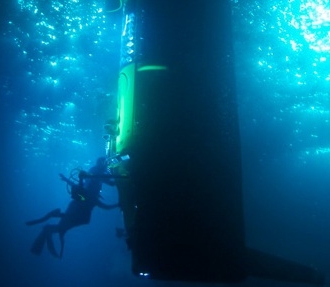LEAP Australia wishes to congratulate Finite Elements Pty Ltd on their impressive use of ANSYS simulation technology during the design and testing of James Cameron's Deepsea Challenge submersible vehicle, which successfully completed its historic expedition to the Mariana Trench’s lowest point, the Challenger Deep, on March 25, 2012.
The Deepsea Challenger submersible became the first single occupant research vessel to safely reach the bottom of the Mariana Trench, which at 11kms below the surface is the deepest part of the world's oceans. The Deepsea Challenger was constructed in a factory in Sydney, and the design involved a 6 year collaboration between James Cameron, Ron Allum and Phil Durbin with his team at Finite Elements Pty Ltd.
 Following his safe return to the surface, James Cameron commented "When you are actually on the dive, you have to trust the engineering was done right." At LEAP Australia, we couldn't agree more and we are proud to provide and support the ANSYS software that enables such ground-breaking feats of engineering & science.
Following his safe return to the surface, James Cameron commented "When you are actually on the dive, you have to trust the engineering was done right." At LEAP Australia, we couldn't agree more and we are proud to provide and support the ANSYS software that enables such ground-breaking feats of engineering & science.
Recently, these design achievements by Finite Elements, in conjunction with James Cameron, Ron Allum's Acheron Project Pty Ltd, Design + Industry and McConaghy Boats, were honoured with receipt of first prize in the 2012 Australian International Design Awards. The judges for the 2012 Australian International Design Awards recognised the Deepsea Challenger design for the high level of innovation & design ingenuity involved, along with the obvious safety considerations and thorough attention to detail which allowed the Deepsea Challenger to successfully complete it's mission and provide hours of footage which will be used in a future 3D feature film by James Cameron. They noted that the Deepsea Challenger was the standout winner in a field of 105 Finalists, all of which showcase the best in design, creativity and innovation from both local Australian and international designers.
For more information on the Deepsea Challenger design and expedition, please visit Finite Elements website and the DeepSea Challenge homepage, sponsored by National Geographic and Rolex. Phil Durbin has also discussed this work in the ANSYS Advantage magazine, please click here for the link to the full article.
In the meantime: Have you also been involved in groundbreaking design using ANSYS CFD technology? Let us know in the comments section below. What technical problems and challenges did you overcome using CFD simulations?
Images are copyright National Geographic and Acheron Project Pty Ltd.






